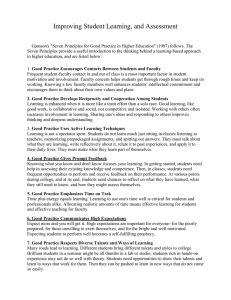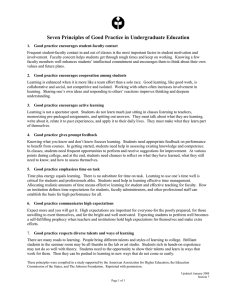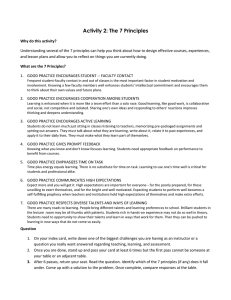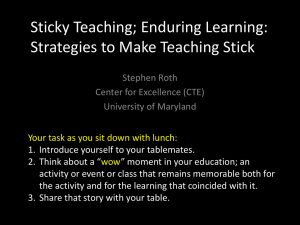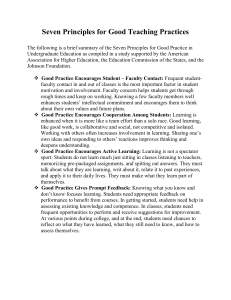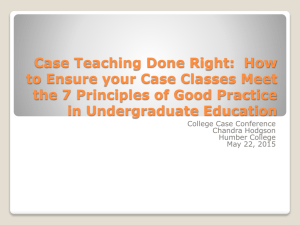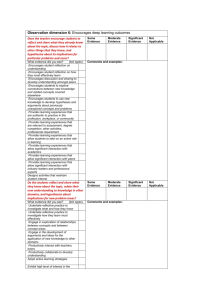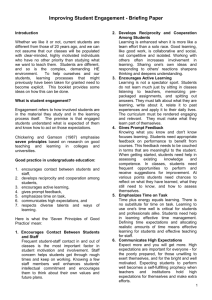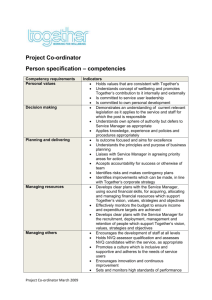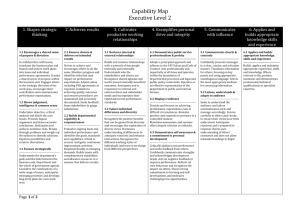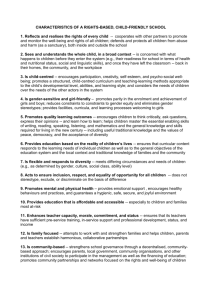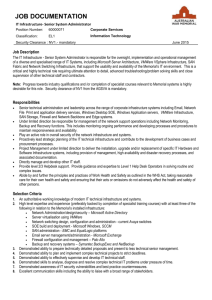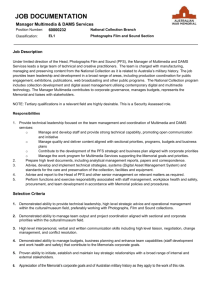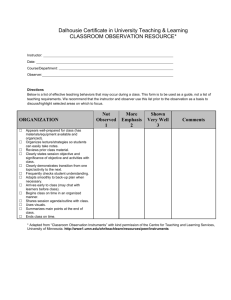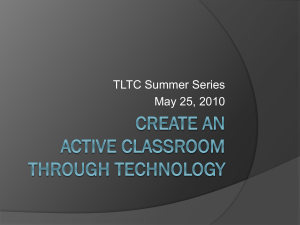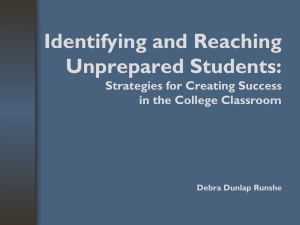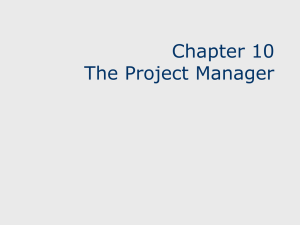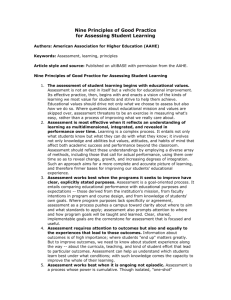7 Principles for Good Practice in Undergraduate Education
advertisement
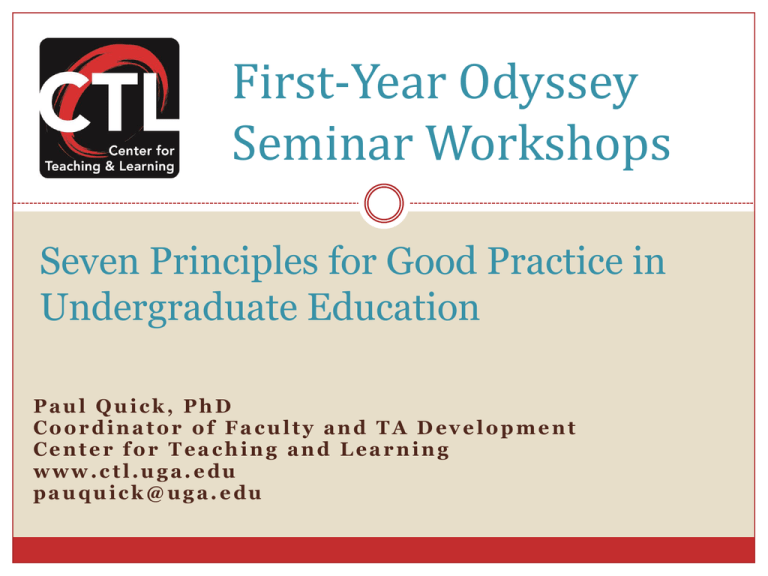
First-Year Odyssey Seminar Workshops Seven Principles for Good Practice in Undergraduate Education Paul Quick, PhD Coordinator of Faculty and TA Development Center for Teaching and Learning www.ctl.uga.edu pauquick@uga.edu Questions via the web? Submit via webform: ctl.uga.edu/fyos/stream via Twitter: @ugactl (use tag #FYOS) 7 Principles of Good Practice Good Practice: 1. Encourages Student-Faculty Contact 2. Encourages Cooperation Among Students 3. Encourages Active Learning 4. Gives Prompt Feedback 5. Emphasizes Time on Task 6. Communicates High Expectations 7. Respects Diverse Talents and Ways of Learning 7 Principles for Good Practice Arthur Chickering and Zelda Gamson, AAHE Bulletin, 1987. Chickering and Gamson publish inventories, 1989. Peter Ewell of NCHEMS incorporates 7 Principles in NSSE, 1995. Chickering and Stephen Ehrman, “Implementing the Seven Principles: Technology as Lever,” AAHE Bulletin, 1996. Kuh and Vespers research on student experience at baccalaureate and research-intensive institituions, 1997. Chickering and Gamson, “Development and Adaptations of the Seven Principles for Good Practice in Undergraduate Education,” New Directions for Teaching and Learning, no. 80, Winter 1999, 75-83. 7 Principles for Good Practice Find your principle Read the components under your principle Pick one that seems most aligned with FYOS goal(s) OR Pick: most important or questionable most confusing/unclear one you have a good example of from your experience one that you can’t figure out how to implement Prepare to discuss with group 1. Encourages Student-Faculty Contact Advise students about career opportunities Encourage students to drop by office Share past experiences, attitudes, and values with students Attend events sponsored by student groups Work with campus staff on issues related to student extracurricular life and life outside of school. 1. Encourages Student-Faculty Contact Know my students by name by the end of 2nd week Make special efforts to be available to students of a culture or race different from faculty’s own Serve as a mentor/informal advisor to students Take students to professional meetings or other events in my field Try to help whenever there is a conflict involving students on campus 2. Encourages Cooperation Among Students Ask students to tell each other about their interests and backgrounds. Encourage students to prepare together for classes or exams Encourage students to do projects together Ask students to evaluate each other’s work Ask students to explain difficult ideas to each other 2. Encourages Cooperation Among Students Encourage students to praise each other for accomplishments Ask students to discuss concepts with other students from different backgrounds and viewpoints Create “learning communities,” study groups, or projects teams within my course Encourage students to join at least one campus organization Distribute performance criteria for fairness and to avoid bias* 3. Encourages Active Learning Ask students to present their work to the class Ask students to summarize similarities/differences among theorists, research findings, or works Ask students to relate outside events/activities to course subjects Ask student to undertake research/independent study Encourage students to challenge instructor’s, reading’s, other students’ viewpoints 3. Encourages Active Learning Give students concrete, real-life situations to analyze Use simulations, role-playing, or labs in classes Encourage students to suggest new readings, research projects, field trips, or course activities Help students arrange field trips, volunteer activities, field trips, service learning, or internships related to course Carry out research projects with my students 4. Gives Prompt Feedback Give quizzes and homework assignments Provide immediate formative feedback to students on classroom exercises and problems Return examinations/papers within a week Give students detailed evaluations of their work early in the term Ask students to schedule conferences with me to discuss their progress 4. Gives Prompt Feedback Give my students written comments on their strengths and weaknesses on exams and papers Give my students a pre-test at the beginning of each course Ask students to keep logs or records of their progress Discuss the results of the final examination with my students at the end of the semester Call or email students who miss class. 5. Emphasizes Time on Task Expect students to complete assignments promptly Communicate the minimum amount of time they should spend preparing for classes Make clear to my students the amount of time required to understand complex material Help students set challenging goals for their own learning Encourage students to rehearse oral reports/class presentations 5. Emphasizes Time on Task Underscore the importance of regular work, steady application, self-pacing, and scheduling Explain the consequences of non-attendance Make it clear that full-time study is a full-time job that requires forty or more hours a week Meet with students who fall behind to discuss study habits, schedules, and other commitments Require students who miss class to make up work 6. Communicates High Expectations Tell students to expect to work hard in class Emphasize high standards for academic achievement Make expectations clear both orally and in writing at the beginning of each course Help students set challenging goals for their learning Explain what will happen if students do not complete work on time 6. Communicates High Expectations Suggest extra reading or writing tasks Provide students with extensive and varied writing opportunities Call attention to excellent performance by students Revise courses Periodically discuss how well class is progressing throughout semester 7.Respects Diverse Talents and Ways of Learning Encourage students to ask questions Discourage language and other class behavior that may embarrass students Use diverse teaching activities to address a broad spectrum of students Select readings and design activities related to the background of students Provide extra material or exercises for students who lack essential background knowledge or skills 7.Respects Diverse Talents and Ways of Learning Include contributions by women and other under represented populations into courses Make provisions for students who carry out independent studies within course or as a separate courses Develop learning contracts, or computer-assisted learning alternatives for courses Encourage students to remain open to different majors Try to find out about students’ learning styles, interests, or backgrounds at the beginning of each course. 7 Principles Resources Online resources and applications http://home.capecod.net/~tpanitz/seven.html Seven Principles and Technology http://www.tltgroup.org/programs/seven.html
